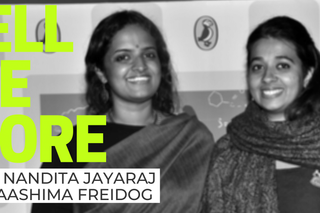
Tell Me More: Talking STEM Education and Bias With the Co‑Founders of The Life of Science
“…The dominant narrative is something like ‘Who will marry you if you do a Ph.D?’ in our society.”

In The Swaddle’s interview series Tell Me More, we discuss crucial cultural topics with people whose work pushes societal boundaries.
Nandita Jayaraj, a science writer and editor, and Aashima Freidog, a science communicator, are the co-founders of feminist science media collective The Life of Science. The Swaddle’s Aditi Murti spoke to both about how India sees girls and women in Science, Technology, Engineering and Mathematics (STEM), and how that affects their minimal representation in STEM fields.
The Swaddle: Recently, you’d put out a Twitter thread about delays in receiving scholarship funding with respect to the Aishwarya Reddy case — the math honors student at Lady Shri Ram College who died by suicide. Are these delays quite common from what you’ve seen in the research landscape?
Nandita Jayaraj: Yup! And not just for students, but even faculty members working with grants who rely on funding for research. I think this is more so for Government funding because private sources are a lot more punctual with their funds. But, with Government, from what we have heard, it’s just a matter of how late it’s going to be.
TS: Are these delays common across all Government colleges or are they specific to some only? From what I’ve heard from students at prestigious spaces like IIT, Ph.D funding generally comes in on time.
Aashima Freidog: So you have to look at who really picks up the funding. In the Indian landscape, there are premier research institutes, and then there are the universities. And you will find more research fellowship money in premier institutes as compared to universities and primarily education institutions like IIT that also have their own internal funding too. For fellowships that come from outside the institutes, I would say across the board — and this is what I’ve heard from the scientists I’ve interviewed — this is the norm. If your fellowship shows up on time…that’s something really odd. Six months to one year of delays are very common, and even further delays too.
TS: If scholarship delays are so normal, is STEM a domain of the privileged only in India?
NJ: I think so. That would explain why most people who reach the top, i.e., a faculty position — the people who reach that stage come from an extremely privileged lot. One reason for that could be that they have a cushion to fall back on, and they haven’t been hampered by things that would make other people drop out.
AF: I agree with Nandita, and definitely research belongs to the elite in India because it’s a question of access. People who access these research funds have to be very comfortable with speaking in English and they have to have the background where you both know when these grant applications are out, and how to fill them up. Then there’s also preparation — you have to be able to afford coaching classes. Also, backgrounds — if you scan through the surnames of people who are in science — you will find mostly upper-caste names. Actually, we’ve been trying to profile somebody at a faculty level or higher on The Life of Science from a Dalit/Bahujan/Adivasi background and it’s been very challenging.
TS: I’ve always wondered if people in Indian science workspaces are far more conservative — both socially and politically.
AF: We have to ask who are the recorded knowledge makers in India? Traditionally, it’s the upper-caste Brahmin sage. And if you bring this up now, people will say stuff like, “Oh, this is history” and all that, but it’s not true. You see Brahminical practices quite commonly in scientific spaces. That way, I see a lot of conservatism in highly funded national institutes, because the line of recording knowledge there is directly coming from the Brahmins, who have a designated relationship with the unknown. Of course, you’ll see a lot of woke scientists on social media, but when you go to these labs you’ll still see the malas and the poojas — we’re not doing as much ‘global’ science as we’re seen to be.
NJ: I’m so amused at how stark the difference is between what we do and what having a scientific temperament is supposed to be like.
AF: For anyone who’s interested in reading more about ritual Hindu practices seen in scientific institutes, do look at Renny Thomas’s work — he’s a sociologist who researched scientific institutes and caste, and he came across a lot of this stuff.
TS: With respect to a gendered perspective, there’s a phenomenon where Indian girls perform exceptionally well in STEM subjects at a school level, but slowly drop off from further studying or working in STEM fields. Why do you think this happens?
NJ: In India the top science jobs still go to people who study in top colleges — where you study matters a lot with respect to the opportunities you get after. In India, your gateway to these colleges are exams like JEE, which is set up so that you can only succeed if you receive expensive coaching apart from school. For various reasons, girls have less access to this. As a result, they perform far worse in these exams than boys do. If you look at the JEE rankings, you’re rarely likely to see a girl receive a rank in the top 100. When I was in school and everyone was going for IIT coaching — nobody said it out loud but there was this acceptance that boys do better at JEE and this is because we have ‘proof.’ And somehow, the reaction to this — instead of demanding a better selection process — is acceptance. So the message young girls start getting after 10th standard is that we’re not good enough and we should go for the next best thing. Or, we’re not good enough in the way the IITs define what good is. Of course, the gender ratio is much healthier in other state universities and colleges, but these are also places that don’t receive as much funding that allows them high quality scientific training and the best opportunities.
AF: So the system is arranged like this — you study, you hope to get a fellowship, you do a Ph.D, a post-doc and then you try to get a faculty position like say, assistant professor, professor and thereon. So there are these entrance exams that gatekeep at an early level. As you go on from there, you see a steady drop — it’s called the ‘leaky pipeline’ and me and Nandita are currently working on a book about it. Briefly, I’ll say there’s bias — science is suitable for boys and men — and then how science works is you rely on being sent to meetings, you rely on being hired, and you know, getting fellowships, awards, recognition, etc. And of course, there’s an all-boys club at the top who are giving recommendations to people they’re comfortable with, and often, these are not women.
TS: But there’s a difference in how this bias plays out in Indian schools in particular. From stories and reports of discrimination in STEM around the world, you find people telling young girls they’re not good at math and they should stay away from it — that’s the subtle reinforcement that happens outside. In India, at a school level, STEM is a bit of a bloodsport right? It’s a very, very competitive place and a lot of girls seem to be performing well in board exams, at least. How does bias occur in an environment like this?
NJ: I’ll comment empirically — it’s definitely not the same situation in India as it is in the West. The idea of science and math is so glorified in India across gender and it’s not like boys get cars, girls get barbies…at least in urban spaces.
AF: It’s not a pink and blue sort of discrimination.
NJ: Yeah, it’s not. So I think the bias in schools takes on a far more subtle tone. One thing I think of is how these biases subconsciously happen in ourselves – the way educators compliment children, for example. We compliment young girls for their looks and young boys for something more cerebral — that’s bound to get internalized. But, I haven’t felt very strongly — from my interviews with women scientists, that is — that discrimination starts out from school. In fact, instances of discrimination are more in number and severity in colleges.
AF: Yeah, it’s not pink and blue, but we do have gender roles across India. I think, there is this idea of ‘soft’ sciences and ‘hard’ sciences. The ‘hard’ science is disciplines like physics and mathematics and the ‘soft’ science is stuff like home science — which is offered only to girls. Then there’s biology which is considered the softest of the research disciplines — there is also psychology on the periphery. We should also look back to how humanity has seen science itself — it’s always seen as something to find, discover and invent. This is not something most cultures think women are meant to do. We do have that particular bias in our culture as well. The first step is always taken by ‘man’ kind, or nature is the ‘feminine’ that the male scientist must understand. Science has always had gatekeepers and it has always been a place for men, by men. But it is doesnt have to be this way.
TS: Nandita, you said this particular discrimination becomes worse in college. Could you elaborate on how and why?
NJ: Off the top of my head, I can remember multiple women scientists telling us about experiences in college where male professors would joke about girls being ‘ornamental’ to the class. I guess, maybe that is happening, because the closer women reach that stage where society thinks it’s time for them to get married, the harder it is for everyone else to see them as scientists. In school, we’re still at an age where that sort of thing is fine. In college, there’s quite a few micro-aggressions — I mean, you can’t really call then that — there’s quite a few outright sexist behaviors that happen. I think this is why girl’s schools and colleges make sense in India — girls who attend these spaces are far more confident and talkative than in co-ed spaces, where they’re a minority around a lot of boys.
AF: Now we’re in 2020, so there’s quite a bit of informal teaching — you go out with your professor for a drink to discuss and stuff. But, we also have a lot of curfews for women in this country, right? The real world of science involves a lot of networking, traveling, exploring the world, asking questions. Girls don’t have the support — internal or external. Of course, there are still girls who do it, but the dominant narrative is something like “Who will marry you if you do a Ph.D.?” in our society.
TS: Plus, as women progress up the research ladder towards Ph.Ds and post-docs, they’re assigned research advisors who are often male. What does this dynamic look like?
AF: Yes, I think this dynamic of the PI (Principal Investigator) and his bunch of students — Ph.Ds and post-docs — there is too much power on one side. Given that we live in a patriarchal society and there’s very little accountability or safeguards for young people in our institutes — I would say this puts students of science in a weaker position quite often. Sexual harassment in the Indian science space is very rampant — it is very hush-hush, but it is very very common. And due diligence is not working — it’s not robust, the country’s laws aren’t followed. Several times, there are no student representatives on committees. So I’d say people at the receiving end of the dynamic that is rigged for one side, like women, are very very uncomfortable. Sometimes students ask — why don’t the students get to grade their PI’s? Why is it only one way? I mean, you can’t even go to participate at a conference without your PI signing off on it. The PI has way too much power over the career path of these students. Plus in Indian science, there is this celebration of working super hard — working till 10 at night. So PIs and the scientific culture in India like to see that — they like to see you come in on weekends and signal that you’re working hard. Only then, you’re likely to be recognized. This really needs to change because it’s putting people at risk, and we’re all accountable, because most Indian research is funded by public money.
NJ: I just want to add that the male PI-female student dynamic is also only one of the many power imbalances that can happen. It can happen with the same genders, or even with castes, which operates at a more insidious level and is brushed under the table often.
TS: The Life of Science also recently put out a piece pulling together the experiences of Indian trans/non-binary/gender non-conforming individuals in STEM. A lot of the struggles described (lack of infrastructure/discrimination) sound similar to what women undergo — is this because of a culture of masculinity in science that looks down upon anyone who’s not an upper-caste male, or is it far more complex?
AF: I don’t think the issues are the same — there are similar themes like sexual harassment, no representation in sexual harassment committees. There’s also the problem of infrastructure, like toilets, not even existing or too far away or not serviced properly. We have this binary understanding of everything — like say the feminine means weak and the men oppress. But imagine walking into a space that’s been created without even thinking about you — even any data collection that we do is stuck in the binary. So like a woman who’s oppressed by patriarchy can also oppress someone who’s gender non-conforming. We’re kind of in this continuum of oppression, and institutes that are supposed to support everybody only support one kind of person.
TS: Nandita, you also wrote about how Bollywood depicts women in STEM. From Shakuntala Devi to Mission Mangal, how do these depictions end up harming how the audience perceives women in STEM?
NJ: So I think one main thing is that it’s never about their science. I wouldn’t call any mainstream depictions of women in science in Bollywood as depictions of women scientists, because they’re not! They’re just depictions of women and we don’t get to know the science part of their lives at all. Plus with Shakuntala Devi, I remember there was some pushback about how she wasn’t even a mathematician — like you can’t call her a scientist because she was only a human computer. I thought that was also kind of unfair, because she was extremely good at arithmetic, and we don’t really know if she had the kind of social capital and encouragement that could’ve allowed her to pursue mathematics. But she still did have that job (arithmetic shows) and she did it damn well, but of course, the movie prefers to focus on how good or bad a mother she was.
AF: Indian society is still uncomfortable with the term ‘women scientist’ and we don’t really know what to do with it. So when we talk about women scientists, we drag along the baggage of what we think a woman is. So being a woman itself becomes a character sketch — you add those things like making puris, and then science is happening on the side.
NJ: But I don’t really know if it harms women in science. I think it does them a disservice for sure. For example with Mission Mangal, I know a lot of scientists who were miffed by the portrayal of women scientist there because it shows stuff like women can only be good scientists if we mold it into stuff women are good at, which in this case is making puris and taking care of our children. A lot of women scientists found that very irritating. I don’t know if there’s any benefits to this sort of portrayals — like as a role model for kids — but it’s just so old and so boring, and we really need to do better. And there’s so much good material — it’s not like the stories are not there. I think Bollywood is missing this massive opportunity by not challenging their audiences.
TS: You both have been science journalists for a while, and you’ve seen the attitude towards women scientists shift from complete ignorance to ‘listicle culture’ in news media that highlights women scientists and leaves it at that. Do you think the media could be doing better with how it puts women scientists in the forefront?
AF: Firstly, I am very encouraged that gender and science is a big topic now. It’s a good thing, and it has to evolve. We do need to go beyond. I think what the media can do is to hold people accountable. It took us time to accept that there is a problem, but we need to ask why. At the official level, there’s a lot of nodding but nobody knows what we’re doing to close the gap. I mean, these are not just stories — people like Aishwarya are losing their lives. These are real problems and we need the Indian science ministries, academies, and high-level leadership to really start working to close the gap.
NJ: We need to stop talking to women scientists — not just when we want a ‘woman scientist’ but when we want a scientist — an expert. If there’s a story on the coronavirus or a flood, instead of going to the default set of male experts, find a woman expert to talk to. It’s super easy and that is the most sincere way you can show you care, rather than ignoring them and doing the odd listicle.
But I also want to defend the media a bit, because sometimes it’s not only about what we do — we also need institutions to meet us halfway. So, like, I’d ask institutions to not be like the Indian Space Research Organization (ISRO). Don’t show us women only when they’re sanctioned to talk, and not just about their lives and their experiences as women. Why doesn’t ISRO allow us to talk to someone like V. R. Lalithambika, who is the director of the human spaceflight mission? As far as I could find out, has she been quoted in any general article about the mission? Why doesn’t M.Vanitha get quoted in an article about Chandrayaan 2? Government research institutes have a lot of issues with confidentiality, and it’s not so easy as simply writing to a scientist and receiving a reply. They need complicated, high-level permissions to speak, and underpaid, overworked journalists who are working to get sources can’t pay this much attention if it’s not accessible to them. So, we need institutions to try to be more transparent and enable inclusion of the media.
Aditi Murti is a culture writer at The Swaddle. Previously, she worked as a freelance journalist focused on gender and cities. Find her on social media @aditimurti.
Related


All the Arguments You Need: to Convince People They Need a Free Media
